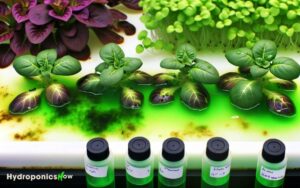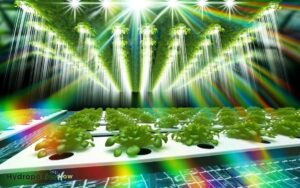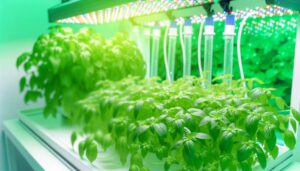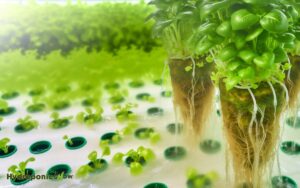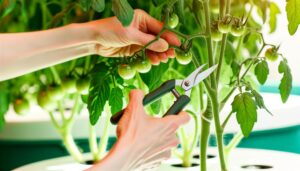Lighting Guide: How Much Light Do Hydroponic Plants Need?
Hydroponic plants need 14 to 18 hours of light daily, depending on species and growth stage. Seedlings prefer lower light intensity with a blue-heavy spectrum, while mature plants thrive with increased intensity and red-heavy light.
LEDs are ideal due to their full spectrum, energy efficiency, and long lifespan. Use a PAR meter to maintain ideal PAR values between 400-700 µmol/m²/s.
Adjust light height to maintain even distribution and prevent overexposure or underexposure. Choosing the correct light spectrum and photoperiod is essential for each growth stage. There are more techniques you can explore to optimize your setup.
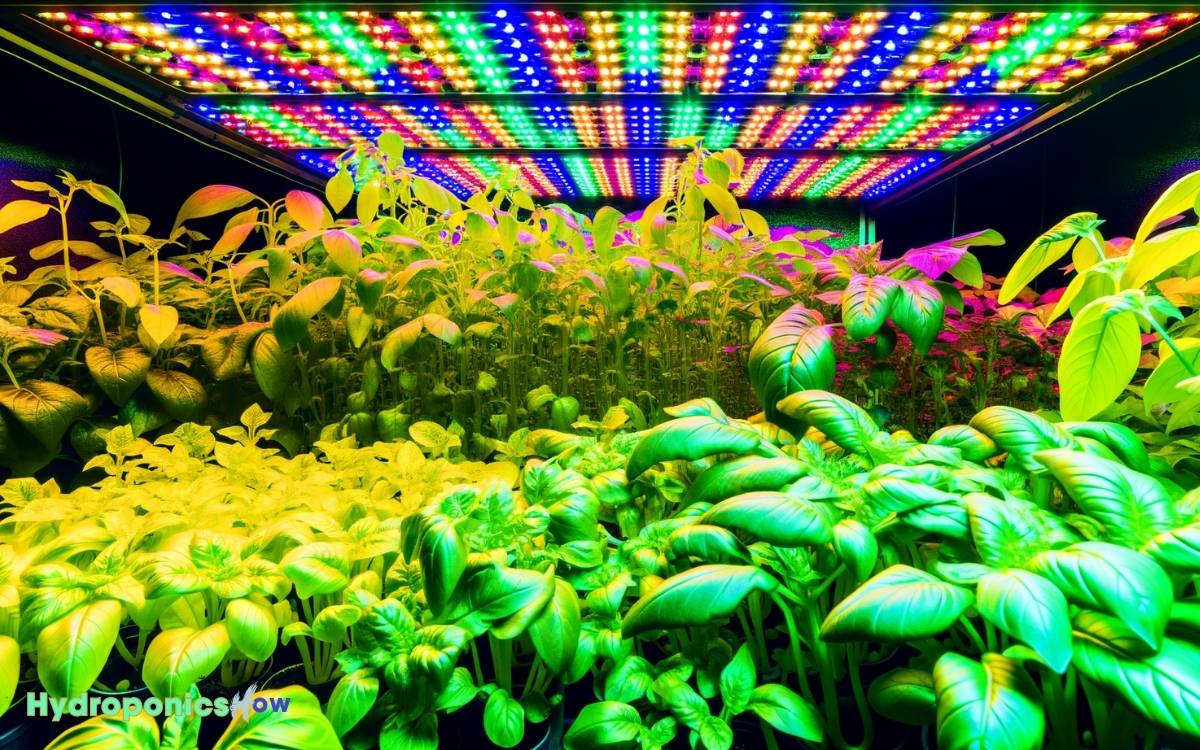
Key Takeaways
Understanding Light Spectra
To optimize the growth of hydroponic plants, you must understand the different light spectra and their specific effects on photosynthesis and plant development. Light spectra refer to the range of wavelengths emitted by a light source.
- Blue light (400-500 nm) promotes vegetative growth, enhancing chlorophyll absorption, which is important for leaf expansion.
- Red light (600-700 nm) stimulates flowering and fruiting by influencing phytochrome-mediated processes.
- Green light (500-600 nm), though less absorbed, penetrates deeper into the canopy, aiding in overall plant morphology.
- Far-red light (700-800 nm) affects photoperiodism, important for flowering in some species.
Balancing these spectra ensures efficient energy utilization and robust plant health. Understanding these nuances allows you to craft precise light recipes, maximizing yield and quality.
Types of Grow Lights
When choosing grow lights for your hydroponic system, you’ll need to compare LED and fluorescent options based on their light spectrum output and energy consumption.
LEDs typically offer a full light spectrum and higher energy efficiency, which can enhance plant growth while reducing electricity costs.
On the other hand, fluorescent lights are less energy-efficient but can still provide adequate light for smaller setups.
LED Vs. Fluorescent
Choosing between LED and fluorescent grow lights requires a detailed understanding of their respective energy efficiencies, light spectra, and operational costs.
LEDs are renowned for their high energy efficiency, offering up to 50% energy savings compared to fluorescents. Additionally, LEDs provide a customizable light spectrum tailored to specific plant needs, whereas fluorescents emit a broader, less targeted spectrum.
Operationally, LEDs boast longer lifespans, often exceeding 50,000 hours, reducing replacement costs and labor.
Conversely, fluorescents, though initially cheaper, have higher energy consumption and shorter lifespans, leading to increased long-term expenses.
LEDs generate less heat, minimizing cooling requirements, while fluorescent lights produce more heat, necessitating additional ventilation.
Hence, a thorough evaluation of these factors will guide your best choice.
Light Spectrum Importance
Understanding the importance of the light spectrum in hydroponic gardening is essential, as different wavelengths of light directly influence various growth stages and physiological processes of plants.
For instance, blue light (400-500 nm) promotes vegetative growth, whereas red light (600-700 nm) is vital for flowering and fruiting. Full-spectrum grow lights mimic natural sunlight, providing a balanced spectrum that benefits all growth stages.
| Light Type | Wavelength Range (nm) | Primary Benefit |
|---|---|---|
| Blue Light | 400-500 | Vegetative growth |
| Red Light | 600-700 | Flowering and fruiting |
| Full-Spectrum Light | 380-780 | Overall plant health and growth |
Using evidence-based grow lights ensures you optimize plant health and maximize yield in your hydroponic garden.
Energy Consumption Comparison
Evaluating the energy consumption of different types of grow lights is essential for optimizing both plant productivity and operational costs in hydroponic systems.
You’ll need to evaluate the following light types:
- LED (Light Emitting Diodes): Highly efficient, producing more light per watt and lower heat output, leading to reduced cooling needs.
- HID (High-Intensity Discharge): Includes MH (Metal Halide) and HPS (High-Pressure Sodium). While effective, they consume more electricity and generate significant heat.
- Fluorescent Lights: T5 and CFL variants offer moderate efficiency but are less intense, suitable for seedlings and smaller plants.
- Plasma Lights: Emerging technology showing potential in efficiency and spectrum balance, though initial costs are high.
Light Intensity Requirements
Determining the best light intensity for hydroponic plants necessitates precise measurement and monitoring to guarantee maximum growth and yield. This involves assessing factors such as the plant species, growth stage, and type of lighting used. A common question that arises is, how far should grow lights be from the plants to provide optimal illumination without causing light stress or heat damage. Regular adjustments and light intensity measurements help ensure plants receive the ideal spectrum and intensity for healthy development.
You must measure Photosynthetically Active Radiation (PAR) to make sure plants receive sufficient photons for photosynthesis.
Most hydroponic plants thrive with a PAR range of 400-700 micromoles per square meter per second (µmol/m²/s). Utilizing a PAR meter, you can quantify this light intensity accurately.
Additionally, consider the Distance-Inverse Square Law, where light intensity diminishes as the distance from the light source increases.
Adjusting the height of LED grow lights or high-intensity discharge (HID) lamps ensures optimal light distribution.
Regular calibration and maintenance of lighting systems prevent fluctuations, maintaining consistent light intensity. Neglecting this can result in suboptimal plant growth and yield.
Duration of Light Exposure
In order to optimize hydroponic plant growth, providing a specific duration of light exposure is essential, typically ranging from 14 to 18 hours per day, depending on the plant species and growth stage.
This exposure period guarantees that plants undergo adequate photosynthesis and metabolic activities.
To determine the best duration, consider the following factors:
- Species-specific requirements: Different plants have unique light needs.
- Growth stage: Seedlings may require less light than mature plants.
- Light intensity: Higher intensity may allow for shorter exposure times.
- Environmental conditions: Temperature and humidity levels can influence light duration needs.
Light Cycles for Plants
Understanding the ideal light cycles for hydroponic plants is essential for maximizing growth and yield. You should aim for specific daylight hours based on the plant species, as inadequate light can hinder photosynthesis, while excessive light may induce photoinhibition.
Additionally, nighttime darkness is vital for respiration and metabolic processes, as evidenced by studies showing improved plant health and productivity with balanced light-dark cycles.
Optimal Daylight Hours
An effective light cycle for hydroponic plants hinges on providing 14-18 hours of light daily, guaranteeing peak growth and photosynthesis. Establishing this ideal photoperiod maximizes chlorophyll production and nutrient absorption.
To achieve this, you should adhere to these guidelines:
- 14-16 hours: Ideal for vegetative growth, promoting robust leaf development.
- 16-18 hours: Enhances flowering and fruiting phases, optimizing yield potential.
- Consistent timing: Use timers to maintain a precise light schedule, reducing plant stress.
- Light intensity: Make sure your grow lights provide 400-700 µmol/m²/s of PAR (Photosynthetically Active Radiation) to support various plant stages.
Nighttime Darkness Benefits
While extended light exposure drives photosynthesis, the absence of light during nighttime is essential for hydroponic plants to undergo respiration and metabolize stored energy effectively.
This dark period allows plants to balance their physiological processes, ensuring peak growth. During darkness, plants convert stored sugars into essential growth components and repair cellular damage.
Scientific studies indicate that a regulated light-dark cycle maximizes plant health. Here’s a detailed breakdown:
| Light Cycle Phase | Primary Plant Activity |
|---|---|
| Daylight | Photosynthesis, energy storage |
| Nighttime | Respiration, energy utilization |
| Vital Period | Hormonal balance, growth signals |
| Extended Light | Overstimulation, stress |
| Complete Darkness | Enhanced root development |
Understanding these phases helps you create ideal light cycles, ensuring your hydroponic plants thrive.
Measuring Light Levels
To accurately measure light levels for hydroponic plants, use a PAR (Photosynthetically Active Radiation) meter to quantify the specific wavelengths of light that facilitate photosynthesis. This tool is crucial for guaranteeing your plants receive the best light intensity and spectrum.
Here’s how you can utilize a PAR meter effectively:
- Calibration: Make sure the PAR meter is calibrated correctly according to the manufacturer’s instructions for precise readings.
- Measurement Frequency: Take readings at different times of the day to account for variations in light levels.
- Light Source Positioning: Measure the light intensity at plant canopy level to determine if adjustments in light source positioning are needed.
- Data Logging: Record the PAR values regularly to track changes and identify trends over time.
Adjusting Light for Growth Stages
Optimizing light exposure for hydroponic plants involves tailoring the intensity and spectrum to their specific growth stages, ensuring maximum photosynthetic efficiency and robust development.
During the seedling stage, use lower light intensity and a blue-heavy spectrum to promote root growth. As plants enter the vegetative phase, increase intensity and maintain a blue spectrum to enhance leaf development.
During the flowering stage, switch to a red-heavy spectrum and further increase light intensity to boost bud formation and yield.
| Growth Stage | Light Spectrum | Light Intensity (PPFD) |
|---|---|---|
| Seedling | Blue (400-500nm) | 100-300 µmol/m²/s |
| Vegetative | Blue (400-500nm) | 400-600 µmol/m²/s |
| Flowering | Red (600-700nm) | 600-900 µmol/m²/s |
Common Lighting Mistakes
Many growers often make the mistake of providing inconsistent light schedules, which can stress hydroponic plants and hinder their growth cycles. Ensuring a stable photoperiod is essential for peak plant development.
Here are four common lighting mistakes to avoid:
- Overexposure: Excessive light can cause photoinhibition, leading to chlorosis and reduced photosynthetic efficiency.
- Underexposure: Insufficient light results in etiolation, where plants stretch and weaken, compromising structural integrity.
- Incorrect Spectral Output: Using lights with improper spectral qualities can disrupt photosynthetic processes and metabolic pathways.
- Inadequate Light Distribution: Uneven light spread can cause localized growth disparities, with some plants receiving too much light and others too little.
Avoid these errors to maintain robust, healthy hydroponic plants and ensure steady growth.
Optimizing Light for Yield
Achieving ideal light conditions is paramount for maximizing yield in hydroponic systems, necessitating precise control over intensity, duration, and spectral composition.
You’ve got to guarantee your lights emit the correct photosynthetically active radiation (PAR) range, typically 400-700 nm. Employing LEDs allows fine-tuning of blue (450-495 nm) and red (620-750 nm) wavelengths, critical for vegetative growth and flowering, respectively.
Maintain light intensity at 200-400 µmol/m²/s for seedlings and 400-600 µmol/m²/s for mature plants. Consistent photoperiods 18 hours of light for vegetative stages and 12 hours for flowering optimize photosynthesis and growth cycles.
Use a PAR meter to measure light distribution, ensuring uniform coverage. Dialing in these parameters will greatly increase plant productivity and yield in your hydroponic setup.
Conclusion
By mastering the art of light management, you’ll cultivate hydroponic plants as lush as the Hanging Gardens of Babylon. Make sure you balance light spectra, intensity, and exposure durations tailored to each growth stage.
Avoid common pitfalls like excessive or insufficient light, which can stunt growth. Remember, precise adjustments and regular measurements are essential for maximum yield.
Your plants’ health and productivity hinge on these scientifically-backed lighting strategies, transforming your hydroponic garden into a verdant oasis.

